At the Turin Motorshow, also in 1971, Fiat
showed a new 128 derived coupe, the 'Sport Coupe'. This had two engines
(the 1116cc unit now with 64bhp and the 1290cc now with 75bhp) and two
trim levels (easily differentiated since one ('S') had single square headlights,
the other ('SL') twin round units). The mechanical parts remained as in
the saloon, but the body was all new, based on a shortened saloon floorpan.
It was designed in-house by Fiat, whilst Bertone was given the task of
designing a 128 Spider, which later emerged as the X1/9.
In 1975 the 128 3P (3 door) replaced the
Sport Coupe. The most significant difference was a rear end new from the
B-pillar back which incorporated a hatchback. The rear seats could also
be folded flat to provide a larger load area. Several other details were
changed at the same time (new grille, lights), whilst in order to meet
more stringent emissions standards the engine was modified (compression
ratio raised, combustion chamber modified).
The second series was introduced in 1976
and included many changes. Externally there were new bumpers, lights and detail
trimmings, whilst the engines were also modified as were the gear ratios, the
driveshafts, brakes and electical system. Internally the dashboard, trim
seats etc were all updated.
The following summarises the models produced (in Europe)
: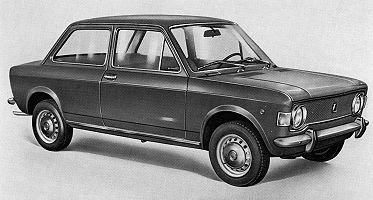 This,
the replacement for the 1100 was introduced in
March 1969. It was the first production Fiat with a completely new
transverse engine (1116cc, 55bhp, cast iron block, light alloy head, sohc
with toothed belt drive) driving the front wheels and was available in
two and four door saloons and an estate version. It was awarded 'Car of the Year' in 1969.
This,
the replacement for the 1100 was introduced in
March 1969. It was the first production Fiat with a completely new
transverse engine (1116cc, 55bhp, cast iron block, light alloy head, sohc
with toothed belt drive) driving the front wheels and was available in
two and four door saloons and an estate version. It was awarded 'Car of the Year' in 1969.
In 1971 the Fiat 128 Rally was introduced with
a more powerful engine (1290cc and 67bhp) and numerous other changes including
different gear ratios, a different alternator and battery, different tyres
and the addition of a brake booster. It was only available with two doors.
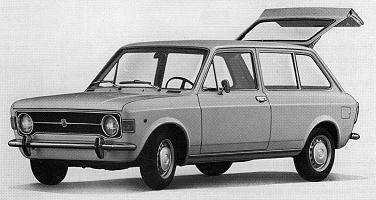 In
1972 the models were mildly revised, such as the fitment of a brake booster
(from the 'Rally' version) across the range. Trim, the grille and other
small changes were made. In 1974 the 'Special' arrived which had the four
door saloon body with the 'Rally' engine (in this application rated at
60bhp) and numerous other minor changes.
In
1972 the models were mildly revised, such as the fitment of a brake booster
(from the 'Rally' version) across the range. Trim, the grille and other
small changes were made. In 1974 the 'Special' arrived which had the four
door saloon body with the 'Rally' engine (in this application rated at
60bhp) and numerous other minor changes.
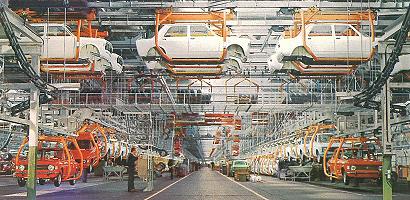 from 1969 :
from 1969 :
Berlina 1116ccfrom 1976 :
Familiare 1116cc
Rally 1290cc
Sport 1116cc ('S') & 1290cc ('SL')
Special 1290cc & 1116cc
Coupe 3P 1116cc & 1290cc
1100 & 1300
Coupe 3P Special 1100 & 1300
In South America the 128 was also produced alongside the 127 which it was closely related to. Continuing in production
later than in Europe, the final version was known as the Super Europa (4-door saloon only) and was fitted either with a 1300 (1290 or 1301cc) sohc with 60bhp or a
1500 (1498cc) sohc with 82bhp. This featured a modernised front and rear end treatment, with 127-like lights and a black plastic trimmed tail. It was
produced until 1990.
The 128 was used as the basis for several prototypes through the years, including a coupè, the
Pulsar, another sort of coupè, by
Bertone and a type of beach car, the
Teenager.
After the Ritmo was introduced 128
production was cutback to only use the 1100 engine, whist in 1980 the Panorama
was dropped from the range. Production finally ceased in 1985. Total production
was 2 776 000 Saloons & estates and 330 800 Coupes and 3Ps.
Technical Details
| Driveline | transverse engine at frontwith front wheel drive |
| Engines | 1116cc (80x55mm) in-line sohc 4 cyl with 55bhp @ 6,000rpm
with 64bhp @ 6,600rpm in the Sport Coupé with 65bhp @ 6,000rpm in the Coupé 3P 1290cc (86x55.5mm) sohc with 60bhp @ 6,000rpm with 67bhp @ 6,200rpm in the Rally with 75bhp @ 6,600rpm in the Sport Coupé with 73bhp @ 6,000rpm in the Coupé 3P from 1976, in the new 128, the 1100 and 1300 engines produced 55bhp and 60bhp respectively, both at 6,000rpm |
| Fuel Consumption |
1977 1300 saloon
Simulated urban cycle 28.0mpg / 10.1 l/100km Constant 56mph 42.8mpg / 6.6 l/100km 1977 1300 estate Simulated urban cycle 28.5mpg / 9.9 l/100km Constant 56mph 39.2mpg / 7.2 l/100km 1977 3P coupe Simulated urban cycle 24.6mpg / 11.5 l/100km Constant 56mph 41.5mpg / 6.8 l/100km |
| Suspension | front : MacPherson strut with telescopic dampers and coil springs plus anti-roll bar
rear : independent with telescopic dampers and single, transverse leaf spring (3 leaves). Wheels and tyres (1974 UK spec)4.5Jx13" wheels with 145x13 tyres (saloon, estate, rally and coupe) wheelbase : 2448mm (coupe : 2223mm) track (front/rear) : 1308mm/1313mm (Coupe : 1325mm/1333mm) |
| Brakes | front : discs. diameter 227mm
rear : drums, diameter 185mm front calliper piston diameter : 48mm rear wheel cylinder bore : 19.05mm handbrake operating on the rear via a cable |
| Gearbox | 4 speed manual
cable operated clutch disc diameter : 181.5mm |
| Steering | Rack and pinion (the first time on a production Fiat car)
3.5 turns lock to lock |
| Kerb Weight | Berlina : 805kg; Rally : 820kg; Sport Coupe S : 815kg |
Click here for a section drawing of a 128 Berlina,
here for a section drawing of a 128 Sport Coupe and
here for a picture of the complete 128 drivetrain.
 |
 |
 |
 |
 |
 |
 |
Tuning
 There are three main areas to concentrate
on, the engine (and transmission), the brakes and the suspension and then
various other details. These three should be done together since they complement
each other, not all of one and none of another !
There are three main areas to concentrate
on, the engine (and transmission), the brakes and the suspension and then
various other details. These three should be done together since they complement
each other, not all of one and none of another !
1. The engine.
Before modifying the engine it is worthwhile
filling it with a good quality synthetic oil and fitting new spark plugs.
An engine oil additive may also be used.
The first improvements are relatively simple.
The air filter can be replaced for an aftermarket item which will help
the engine breathe more freely and the exhaust can be replaced for one
which will restrict the exit of the gases less.
The main modification (outside of taking the engine apart) is to fit a better
carburettor. Either a unit from a larger engined model, or you can buy
a special inlet manifold to allow the fitment of other units. A camshaft
will also provide a noticeable gain, especially if fitted in conjuction
with the carburettor.
Further modifications require the machining
of the cylinder headand/or cylinder block (which will not be dealt with
here since it is not normally a DIY job) after which it may be worth fitting
an oil cooler. If overheating is a problem due to the increased power output
then a small hole can also be drilled through the plate in the thermostat.
Regarding the transmission the main requirement
is to uprate the clutch to handle the increase in power and torque achieved
though the engine modifications. Friction plates can be purchased with
improved materials and heavier duty pressure plates are also available.
Whilst doing this it is worthwhile lightening the flywheel.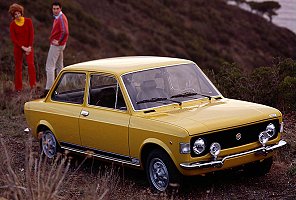 Other things to do should include fitting
a cold air intake, a large diameter pipe (minimum 5cm) to provide air from
outside the engine bay to the air filter. The exhaust manifold can also
be lagged with thermal cloth or tape to keep the exhaust gases hotter (and
thus reduce back pressure) and also to keep the underbonnet (and hence
intake and fuel) temperatures lower.
Other things to do should include fitting
a cold air intake, a large diameter pipe (minimum 5cm) to provide air from
outside the engine bay to the air filter. The exhaust manifold can also
be lagged with thermal cloth or tape to keep the exhaust gases hotter (and
thus reduce back pressure) and also to keep the underbonnet (and hence
intake and fuel) temperatures lower.
The high tension leads can also be replaced with performance ones.
2. The brakes.
If more serious braking is required the
next modification would be to increase the disc size. It is possible to
use larger discs with a bracket allowing use of the production callipers,
or alloy four pot callipers can be fitted.
In order to improve the balance of the
car under braking it is desireable to be able to adjust the balance of
braking from front to rear (and vice versa). This can be accomplished by
fitting a bias valve in the line to the rear brakes, usually in a position
so that it can be reached from the drivers seat.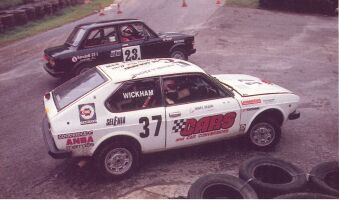 Initially it is relatively easy to replace
the brake discs with drilled and grooved items, and the pads for a harder
compound. The latter should not be too hard (ie no race pads on the road)
or they will not function effectively at the normal 'road' operating temperatures.
Stainless steel braided flexible hoses will improve the pedal feel and
reduce the chance of damage whilst DoT5 fluid (not silicon) will increase
the temperature at which it can operate effectively. If the brakes are
getting too hot the dustguards can be removed and/or ducts fitted, taking
air from behind the front bumper.
Initially it is relatively easy to replace
the brake discs with drilled and grooved items, and the pads for a harder
compound. The latter should not be too hard (ie no race pads on the road)
or they will not function effectively at the normal 'road' operating temperatures.
Stainless steel braided flexible hoses will improve the pedal feel and
reduce the chance of damage whilst DoT5 fluid (not silicon) will increase
the temperature at which it can operate effectively. If the brakes are
getting too hot the dustguards can be removed and/or ducts fitted, taking
air from behind the front bumper.
3. The suspension.
The easiest improvement,and the one which
will probably bring the single most noticeable change, is to replace the
dampers and springs. At the front, everything can be replaced, at the rear
the suspension can be lowered by clamping the leaf spring. Top adjustable
dampers are compromised, but are good for road and track day cars since
it allows the suspension to be adjusted between these two, rather different,
requirements. Coil over units add more adjustability and can be purchased
outright, or can be made from standard dampers by welding a threaded sleeve to the standard tube.
Into this category also fall the choice
of wheels and tyres. With an increase in power it can be necessary to fit
larger tyres (thus requiring larger wheels) but the temptation to fit the
biggest possible should be resisted. Consideration should be given to fitting
a wider tyre on the front (since they provide traction and steering) but
keeping the standard, or a wider but not as wide as the front, tyre at
the rear. This will improve the balance of the car. There are then two other main suspension aims; to reduce the flexiblity in the suspension and to increase the stiffness
of the car, both of which aim at more accurate control of the wheel movement.
To reduce the flexibility it is possible to fit nylon bushes instead of
the normal production rubber items, or if perfection is desired the suspension
can be fitted with metallic bearings (rose joints / rod ends). Spherical
bearing top mounts can also be used. To stiffen the car it is most popular
to fit strut braces. These can be fitted to the front and rear. For more
extreme cases a rollcage can be fitted.....
There are then two other main suspension aims; to reduce the flexiblity in the suspension and to increase the stiffness
of the car, both of which aim at more accurate control of the wheel movement.
To reduce the flexibility it is possible to fit nylon bushes instead of
the normal production rubber items, or if perfection is desired the suspension
can be fitted with metallic bearings (rose joints / rod ends). Spherical
bearing top mounts can also be used. To stiffen the car it is most popular
to fit strut braces. These can be fitted to the front and rear. For more
extreme cases a rollcage can be fitted.....
4. other things.
Other modifications worth considering include fitment of a shift light (and rev limiter if there is not one as standard), higher power bulbs in the headlights (if you are going to go faster you need to see further) and installation of a quicker steering rack.
Maintenance
Scheduled maintenance :
Replace air filter : every 10 000km
recommended engine oil : in cold climates (min temp below 0°C) SAE 10W/30, in warmer climates 20W/40
engine oil capacity (sump & filter) : 4.25 litres
Spark plugs : Champion N9Y or Bosch W200T30, gap 0.5mm to 0.6mm
tyre inflation pressures (front/rear) : 1.8bar / 1.7 bar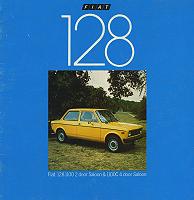 The following data refers to the 1978 saloon :
The following data refers to the 1978 saloon :
Check tappet clearances : every 10 000km
Replace timing belt : every 60 000km
Oil & filter change : every 10 000km or 12 months
recommended transmission oil : SAE 90 non-EP
transmission oil capacity : 3.15 litres
Buying / Selling
Some tips to do before selling :
(they may seem obvious, but most people don't do them and thus are in a weaker bargaining position).
Tidy inside the car thoroughly : hoover
the floor, empty all pockets, ashtrays (wash), glove compartment etc...,
wipe the trim with a damp cloth, give the cockpit a good airing to get
rid of any odours ! Reset the trip meter to 00000 - it is a pleasant (subconcious) surprise.
If the car has been standing give it a
good run - this will clear out the engine (reduce exhaust smoke), put a
shine on the brake discs 'Back to black' products are very effective
at temporarily restoring bumpers and trim. This makes a big difference
to any car. Do it a week before you expect people to view the car, otherwise it may be a bit too obvious !
Jetwash under the car, especially under
the engine and in the wheelarches. The prospective buyer may be an enthusiast,
and this makes it easier for them to see what they want to check.
Obviously wash the car and clean the windows !
If you are going to buy a car always check the following :
Firstly check the bodywork. Pay special
attention to the wheelarches (inside if there is no plastic splash guard),
suspension and engine mounts, sill, door pillars (check for sagging doors),
scuttle panel and the floor (doors, bonnet and boot/hatch are also susceptible,
but are more easily replaced). If a sunroof is fitted check around the
edge for signs of rust. Check that there are no mismatching panels, large
areas of discolouration or signs of fresh paint (compare inside the engine
bay with the external body colour), all of which probably indicate accident damage.
Check for a damp carpet or the presence
of mould - if the carpet is damp then the floor is almost certainly corroded.
Check the main electrical functions - wipers,
lights, etc... try putting the main beam and wipers on at the same time.
Check the headlight reflectors for rust.
The engine should be run up to temperature,
check the exhaust for smoke, the condition of the breather (look for mayonaise),
the condition of the oil filler cap (again white deposits can indicate head
gasket or other serious problems or the use of the car only on short journeys,
another bad state of affairs) and the colour of the coolant (preferably
not thick or dark brown!). Listen to the noise of the engine, then depress
the clutch and engage first gear. Whatever noise has disappeared was coming
form the gearbox, what remains is from the engine. Also check the condition
of the engine oil on the dipstick.The lighter brown the better, if it is thick black then leave quickly.
Check tyre wear, uneven patterns could imply a bent chassis.
Always take it for a test drive. Check
that the car tracks in a straight line with no steering input and also
remains straight under braking. Find a large open area and complete several
lock to lock turns (also in reverse), listening for any noises. Try the
handbrake when moving - seized rear callipers will mean uneven braking or no braking.
Generally, the 128 is mechanically pretty
good, but the bodywork was weak, especially with the age of the cars now !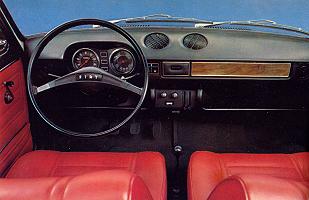 and
loosen up any joints that may otherwise make some noises.
and
loosen up any joints that may otherwise make some noises.
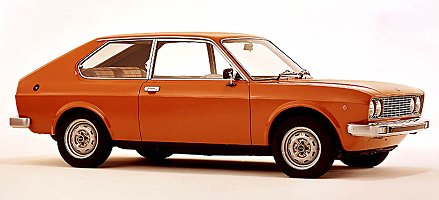 Check
the brake pedal does not go to the floor if pressed hard for a long time
and check the gearchange for clean engagement.
Check
the brake pedal does not go to the floor if pressed hard for a long time
and check the gearchange for clean engagement.
Links
An excellent Argentinian 128 website (in Spanish but worth browsing !)
For books on Fiat see our Online Bookstore
There is also a list of all our picture galleries (including museums, motorshows and various events).
Wallpapers/Desktop Backgrounds of numerous Fiats including the 128 are available to download.
128 comment form
Your Comments
The 128 marked the start
of an era of front-wheel-drive. The end-on gearbox and engine mounting
arrangement has been adopted by almost every other successful design since.
The engineering of these boxy little cars stands proud even after the often-criticised
styling is long forgotten, proving that beauty really is more than skin deep.
I have a '73 128 coupe, the
third one I have owned (actually, one was a '74 parts car). I have concentrated
on the suspension and drivetrain mainly, with cosmetics taking a backseat
for now. When I bought the car, it was completely roached. The only thing
it had going for it at that point was it was straight and (barely) driveable.
I have since added new suspension, Konis with coilovers up front, and new
a-arms and a de-arched rear spring out back. Brand new brakes have been
I bought a 128 3P in 1985 for £600 and had it for nearly 4 years. It is the best car I ever owned and I wish I had never sold it. It sounded great & handled like a Kart - point & go. It's the kind of car that when driving it you end up smiling and modern cars just don't have the same effect. It makes you feel like a great driver and when getting in many other cars all you see & hear is blandness.
This was one thing the 3P wasn't and could never be. One day I want to find another like mine and relive those days 15 years ago. I want to be able to show all those I have bored with stories of its greatness what I mean & hit 7,500rpm once again. (Terry, UK)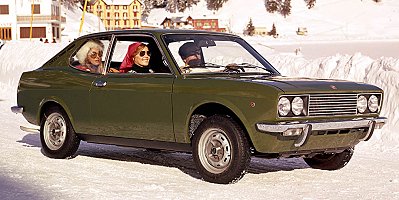 Just as well, since that
skin is all too likely to have rotted away by now... The most dangerous
part of 128s is probably the front anti-roll bar triangular mount to the
body - a perfect rust trap. Less important but still major is the front
floorpan, which starts off in life as double-skinned, but sometimes this
is hard to tell for sure. Before buying any 128, jack it up with a trolley
jack under the front of the engine supporting beam. If the doors still
open and close nicely, buy the car. Rust holes in door bottoms, boot corners,
top of front wings etc. are common but minor problems. But if the body
flexes when jacked up, you have rust in the floorpan, inner screen pillars,
inner wings and at the very least misaligned doors from a smash (which
are VERY difficult to put right...)
Just as well, since that
skin is all too likely to have rotted away by now... The most dangerous
part of 128s is probably the front anti-roll bar triangular mount to the
body - a perfect rust trap. Less important but still major is the front
floorpan, which starts off in life as double-skinned, but sometimes this
is hard to tell for sure. Before buying any 128, jack it up with a trolley
jack under the front of the engine supporting beam. If the doors still
open and close nicely, buy the car. Rust holes in door bottoms, boot corners,
top of front wings etc. are common but minor problems. But if the body
flexes when jacked up, you have rust in the floorpan, inner screen pillars,
inner wings and at the very least misaligned doors from a smash (which
are VERY difficult to put right...)
Engines respond well to
a quick'n'dirty rebuild - new rings, decarbonised head, valve grind and
new gaskets throughout. Bore wear is not often excessive because of the
very short-stroke (therefore low piston speed) design. The massive crankshaft
and bearings, oil pump and simple direct-acting valvegear also last well,
although setting the valve clearances needs the help of an agent.
Gearboxes don't seem to
be particularly strong (by comparison.) Expect poor synchro on second or
third gears. Check for whining in top gear or irregular churning or growling
noises at low speeds - if either of these faults exist, swap the gearbox.
All parts are available at reasonable cost (eg. synchro hub is about the
price of two cheap new tyres, and well worth doing) but bearings sets are
expensive. Using engine oil in the gearbox is a good cheap option - DON'T
use EP-grade oil.
Wheel bearings are difficult
to change, requiring a press, although the sealed bearings themselves are
cheap. CV joints and driveshafts in these cars last very well, but check
the inside boots regularly for leaks, as these hold the gearbox oil in.
Failure can lead to expensive bearing damage!
Electrical equipment (starters,
alternators etc.) is readily available being shared with other Fiats -
it is also easy to repair and solidly engineered. For example, the radiator
fan motor is particularly efficient and sturdy. Electrical problems on
the whole are most likely related to poor connections. In particular, make
sure the transmission has a braided strap coming off it, fastened to the
steering rack bracket - this acts as the ground for the heavy starter current.
If the strap is broken, the current flows through the clutch cable... over
time, this leads to breakages at the clutch arm end!
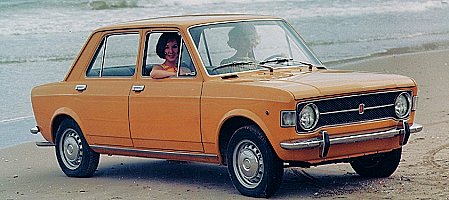 Brakes are a very common FIAT design and parts are thus readily available (and
cheap.) Remember to check the rear brake shoes before re-adjusting the
handbrake - the rear brakes do very little work and are prone to severe
neglect! If the master cylinder is removed, check carefully the protrusion
of the push-rod from the brake servo, which should be 1.05-1.27mm for early
cars, and less than 1mm for later cars. More than this will result in brakes
not always working (M/C not refilling properly) or brake binding and locking on.
Brakes are a very common FIAT design and parts are thus readily available (and
cheap.) Remember to check the rear brake shoes before re-adjusting the
handbrake - the rear brakes do very little work and are prone to severe
neglect! If the master cylinder is removed, check carefully the protrusion
of the push-rod from the brake servo, which should be 1.05-1.27mm for early
cars, and less than 1mm for later cars. More than this will result in brakes
not always working (M/C not refilling properly) or brake binding and locking on.
Interior parts are cheaply
designed (although more solid on early cars) and often difficult to repair/replace.
In particular the dashboard - very few crack-free examples still exist!
The all-vinyl seats fitted to earlier cars (later cars are much better)
are very poor compared with modern standards, although if they are re-covered
properly they can still be comfortable and attractive.
Facilities such as heating
and lighting are adequate, but the front quarter-light windows are a notorious
problem on saloons and likewise the rear side windows on Coupes - the attachments
fall off the glass. Loctite glass bond works - for a while. Try 'Super
Glue'! Another small problem in this area is the heater water valve, which
sticks 'on' and relies on a cable pushing to turn it off (weak.) Try using
penetrating oil spray, otherwise obtain a new part. Also, grease the control
cables thoroughly and make sure the cold air flap closes fully or there
won't be any heat...
Before winter sets in, clean
all the ignition components and consider fitting an electronic ignition
box (in series with the points.) This allows the points to last much longer.
Set the gap using a dwell meter - 55 degrees - and then set the timing
at idle speed to 10 degrees BTDC. Shine the timing light down between the
yellow plastic belt cover and the side of the engine bay - you should see
three bumps on the cover and a nick in the V-belt pulley, which should
be lining up with the first bump on the left. Slacken the single nut at
the base of the distributor and move it as necessary. Remember to have
set the points gap first, since this greatly affects the timing.
In the winter time, the
air cleaner needs to be on the warm air intake, and the engine may require
a few moments running before it will pull smoothly.
Finally, remember that the
128 uses a short-stroke engine of 'modern oversquare design'. It is built
for Italian driving, and you won't wreck it by driving it hard! Quite the
opposite in many ways. Of course, a neglected car can be very dangerous
at any speed, but assuming the car is in good order, brisk usage will keep
the engine, brakes and exhaust system in good condition. Particularly avoid
running more than 5km with the choke on, use the brakes hard once a week
or so, and avoid short journeys where condensation rots out the exhaust.
(Alex S., New Zealand)
 fitted, even a new rear proportioning valve. New Speedline "Iron Cross"
wheels (X/19) and Sumitomo 185/60/13 tires have been fitted, and I installed
a rebuilt cylinder head, DCOE Webers, and a Daytona header I saved from
my last coupe. The best upgrade I have made so far has been a 5-speed conversion,
from a Ritmo. I had to make some half-shafts for it, which unfortunately
are starting to twist, so I'll have to have some new ones made. That stopped
the car from screaming it's lungs out on the freeway! I can't understand
why Fiat under-geared those torquey engines. Like my last coupe, it's a
ball to drive. My favorite sport is to find a kid with a tarted-up Honda,
which locally are of the stickers and huge exhaust variety, lowered onto
the bumpstops, most of which are slower than stock, and I like to tickle
them up to their top speed, then pass them calmly sipping a soda! Psychological
warfare like that has a devastating effect, especially when they have their
girlfriends on board! (Ross W.C, USA)
fitted, even a new rear proportioning valve. New Speedline "Iron Cross"
wheels (X/19) and Sumitomo 185/60/13 tires have been fitted, and I installed
a rebuilt cylinder head, DCOE Webers, and a Daytona header I saved from
my last coupe. The best upgrade I have made so far has been a 5-speed conversion,
from a Ritmo. I had to make some half-shafts for it, which unfortunately
are starting to twist, so I'll have to have some new ones made. That stopped
the car from screaming it's lungs out on the freeway! I can't understand
why Fiat under-geared those torquey engines. Like my last coupe, it's a
ball to drive. My favorite sport is to find a kid with a tarted-up Honda,
which locally are of the stickers and huge exhaust variety, lowered onto
the bumpstops, most of which are slower than stock, and I like to tickle
them up to their top speed, then pass them calmly sipping a soda! Psychological
warfare like that has a devastating effect, especially when they have their
girlfriends on board! (Ross W.C, USA)
I bought a 128 in "72. My first new car. Drove it 100,000 miles all over the US and part of Canada. Finally traded it when my first child was on the way and a/c was needed to make it through the Texas summer. I've owned a bunch of new cars through the years, but have never enjoyed driving any car as much as that old 128. There was really something special about that car. My fantasy, like Terry's, is to drive one again. But, alas, there aren't many left here in Texas and I fear I will have to settle for happy memories of the car I never tired of driving. (Patrick)
I am a proud owner of a FIAT 128 mod. 1973 berlina. It was given to me by a relative. Although it is almost 30 years old, it is still
capable to move fast. Its sound is simply adictive. One year ago carrying three other persons I managed to reach a speed of 100 km/h leaving behind in acceleration more
powerfull cars. For a car aged 30 years and of only 1.116 cc it is an astonishing achievement. My FIAT is a piece of my heart. (Nikos, Greece)
I owned a1971 128 2 door in a lawn mower green type colour back in 1975. I adored it, for an1100cc engine it sounded and drove like a little racing car and loved being thrashed . That
little car never let me down and always started 1st time no matter what the weather was like. Later on in 1981 I bought a 1972 one in blue, that went like a rocket too but one day on the
M62 motorway the entire front end of the car tried to part company with the rest of itself due to terminal rot in the front floorpan and chassis rails. what a typically sad end for a Fiat
of the 70s, engine still like new but body rotton to the core. I now own a new grande punto it is clinical and nothing like my lovely old 128s were like to drive they were proper little
drivers cars with a real heart and lovable character. Cheers and congrats on a great website (Mark, UK)
I had a 76 and 2 79s and the three were great cars for been 1.3 engines. With some modifications you can go side by side with any modern car. The only bad thing of the 128
is that the chasis rips off with the extra power. Im 27 and 8 of my 9 cars were FIATs and now I own an HGT BRAVO. (Sebastian, Argentina)
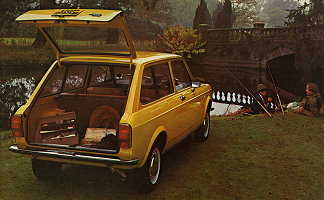
Use the buttons at the top to navigate further, or
Copyright © 2000 to 2008 CarsfromItaly